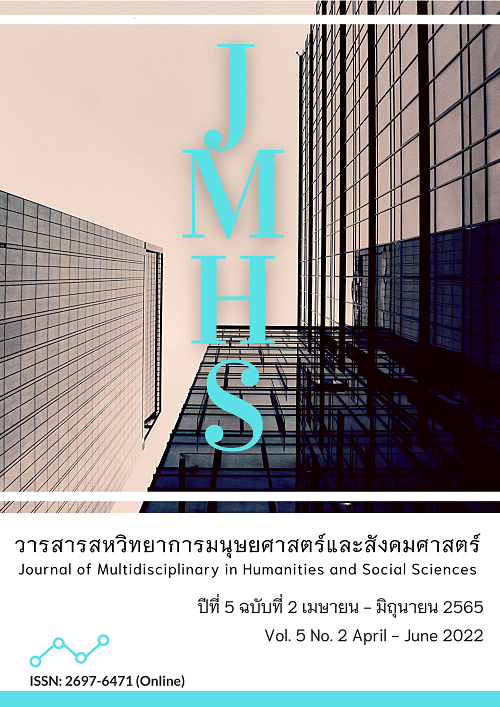An Analysis of Dharma Principles for Vipassana Meditation Practice in Hemavata Sutta
Main Article Content
Abstract
The objectives of this article were 1) to study the contents and important teachings found in Hemavata Sutta and 2) to analyze of Dharma Principles for Vipassana Meditation Practice in Hemavata Sutta. It was a documentary work, done by collecting data from Theravada Buddhist texts and other scriptures concerned, then bringing it to a summary, analyzing, and finally writing in descriptive type. The findings of research In Hemavata Sutta, it is found that the teachings used for insight practice were as follows: 1) six inner sensual organs help insight as observing objects for the practitioners to observe six inner organs, i.e., eyes, ears, nose, tongue, body and mind, and six outside organs, i.e., visible objects, sound, smell, taste, and touch; 2) inner five senses which refer to various pleasurable objects including eyes, ears, nose, tongue, tangible body functioning to perceive outside information for example, one without eyes is able to perceive visible objects as well as sensual attachment mentioned; and 3) three Trainings support insight practice by synthesizing Noble Eightfold Path withing one moment of realization, i.e., Sila or morality includes right work, right speech, right livelihood, Samadhi or concentration covering right effort, right mindfulness and right concentration, Panna or wisdom including right view, right perception. The insight meditator must observe feelings as well as manners clearly appearing from 6 sensual doors as they really are, in this way, they soon gain the best benefits in both worldly and spirituality, in this life and hereafter. The three Trainings are in its essence the Noble Path arising within morality, concentration, and wisdom ever-reminded by the meditators.
Article Details

This work is licensed under a Creative Commons Attribution-NonCommercial-NoDerivatives 4.0 International License.
Views and opinions appearing in the Journal it is the responsibility of the author of the article, and does not constitute the view and responsibility of the editorial team.
References
จิรพร ชีวะธรรม และ อุทัย สติมั่น. (2564). วิเคราะห์การพัฒนาชีวิตตามหลักธรรมที่ปรากฏในพระไตรปิฎก. วารสาร มจร บาฬีศึกษาพุทธโฆสปริทรรศน์, 7(1), 96-106.
พระธรรมกิตติวงศ์ (ทองดี สุรเตโช). (2548). พจนานุกรมเพื่อการศึกษาพุทธศาสตร์ ชุดคำวัด. (พิมพ์ครั้งที่ 2). กรุงเทพฯ: ช่อระกา.
พระธรรมธีรราชมหามุนี (โชดก ญาณสิทฺธิ). (2538). คำบรรยายเรื่องวิปัสสนากรรมฐาน เล่ม 7-8-9. (พิมพ์ครั้งที่ 2). กรุงเทพฯ: สหธรรมิก.
พระพรหมคุณาภรณ์ (ป.อ. ปยุตฺโต). (2554). พจนานุกรมพุทธศาสน์ ฉบับประมวลศัพท์. (พิมพ์ครั้งที่ 16). กรุงเทพฯ: สหธรรมิก.
พระพุทธโฆสเถระ. (2554). คัมภีร์วิสุทธิมรรค. (สมเด็จพระพุฒาจารย์ (อาจ อาสภมหาเถร), แปล). (พิมพ์ครั้งที่ 10). กรุงเทพฯ: ธนาเพรส.
พระมหากิตติณัฏฐ์ สุกิตฺติเมธี. (2564). การวิเคราะห์แนวทางงดเว้นจากความเสื่อมในปราภวสูตร. วารสารสหวิทยาการมนุษยศาสตร์และสังคมศาสตร์, 4(1), 84-95.
พระสมชาย บัวแก้ว, พระมหาบุญศรี วงค์แก้ว และ สุเชาวน์ พลอยชุม. (2564). อภิสมาจาร: กระบวนการพัฒนาบุคลิกภาพตามแนวพระพุทธศาสนา. วารสารศิลปการจัดการ, 5(3), 895-907.
พระโสภณมหาเถระ (มหาสีสยาดอ). (2552). ธัมมจักรกัปปวัตนสูตร. กรุงเทพฯ: ประยูรสาส์นไทย การพิมพ์.
พระโสภณมหาเถระ (มหาสีสยาดอ). (2560). เหมวตสูตร พระสูตรว่าด้วยพระพุทธคุณโดยละเอียด. กรุงเทพฯ: ประยูรสาส์นไทย การพิมพ์.
มหาจุฬาลงกรณราชวิทยาลัย. (2539). พระไตรปิฎกภาษาไทย ฉบับมหาจุฬาลงกรณราชวิทยาลัยกรุงเทพฯ: โรงพิมพ์มหาจุฬาลงกรณราชวิทยาลัย.
มหาจุฬาลงกรณราชวิทยาลัย. (2552). อรรถกถาภาษาไทย ฉบับมหาจุฬาลงกรณราชวิทยาลัย. กรุงเทพฯ: โรงพิมพ์มหาจุฬาลงกรณราชวิทยาลัย.
สุชาดา ทองมาลัย, ประเวศ อินทองปาน และ ธเนศ ปานหัวไผ่. (2561). วิเคราะห์ความสัมพันธ์ของการปฏิบัติสมถภาวนาและวิปัสสนาภาวนาต่อการบรรลุธรรม. วารสารมนุษยศาสตร์, 25(2), 376-409.
สุภีร์ ทุมทอง, (2553). อริยมรรค. สมุทรปราการ: ขุนทองอุตสาหกรรมและการพิมพ์.
Chanthathong, S. (2021). The Significance of the Right View (Sammaditthi) in Theravada Buddhism. Journal of International Buddhist Studies, 12(1), 61-70.
Tan, C. C., & Damnoen, P. S. (2020). Buddhist Noble Eightfold Path Approach in the Study of Consumer and Organizational Behaviors. Journal of MCU Peace Studies, 8(1), 1–20.


